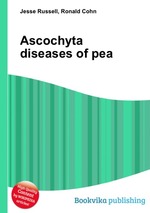Ascochyta diseases of pea
Jesse Russell Ronald Cohn
бумажная книга
High Quality Content by WIKIPEDIA articles! Ascochyta blights occur throughout the world and can be of significant economic importance. Three fungi contribute to the ascochyta blight disease complex of pea (Pisum sativum).Ascochyta pinodes (sexual stage: Mycosphaerella pinodes) causes Mycosphaerella blight.Ascochyta pinodella (synonym: Phoma medicaginis var. pinodella) causes Ascochyta foot rot, and Ascochyta pisi causes Ascochyta blight and pod spot. Of the three fungi, Ascochyta pinodes is of the most importance. These diseases are conducive under wet and humid conditions and can cause a yield loss of up to fifty percent if left uncontrolled. The best method to control ascochyta blights of pea is to reduce the amount of primary inoculum through sanitation, crop-rotation, and altering the sowing date. Other methods--chemical control, biological control, and development of resistant varieties--may also be used to effectively control ascochyta diseases.


